运基通信[2006]185号 GSM-R与CTC系统接口规范
CTCS-3级列控系统GSM-R网络需求要求规范(V1.0)

科技运[2008]168号CTCS-3级列控系统GSM-R网络需求规范(V1.0)2008年12月修改记录目录修改记录 (I)目录 (2)1................................................................................... 引言41.1目的和范围 (4)1.2缩略语 (4)1.3参考文献 (6)2..................................... CTCS-3级列控系统与GSM-R网络之间的界面73..................................... CTCS-3级列控系统对GSM-R网络的业务需求83.1数据承载业务 (8)3.1.1数据承载业务 (8)3.1.2数据承载业务特性 (8)3.2补充业务 (8)3.2.1补充业务 (8)3.2.2补充业务类型 (8)3.3铁路特殊业务 (9)3.4需要特殊说明的问题 (9)4................................................................. GSM-R网络Q O S要求104.1一般规定 (10)4.2网络注册时延 (10)4.2.1定义 (10)4.2.2指标要求 (10)4.2.3其它说明 (10)4.3连接建立时延 (11)4.3.1定义 (11)4.3.2指标要求 (11)4.3.3其它说明 (11)4.4连接建立失败概率 (11)4.4.1定义 (11)4.4.2指标要求 (11)4.5用户数据帧传送时延 (12)4.5.1定义 (12)4.5.2指标要求 (12)4.5.3其它说明 (12)4.6链路断开(失效)概率 (12)4.6.1定义 (12)4.6.2指标要求 (12)4.7传输干扰 (13)4.7.1定义 (13)4.7.2指标要求 (14)5................................................................. GSM-R网络设计要求155.1GSM-R网络与RBC 互联的要求 (15)5.1.1MSC与RBC的连接方式 (15)5.1.2MSC与RBC的接口设置 (15)5.2无线覆盖要求 (15)5.2.1无线覆盖指标要求 (15)5.2.2无线覆盖范围要求 (16)5.2.3越区切换要求 (17)5.3无线小区容量要求 (17)5.3.1RBC切换区无线容量要求 (17)5.3.2枢纽和大站无线容量要求 (18)1.引言1.1目的和范围1.1.1.1为明确CTCS-3级列控系统与GSM-R网络之间的接口界面,并为承载CTCS-3级列控业务的GSM-R网络设计、测试及产品研发提供技术依据,特制订本规范。
GSM规范及移动通信

GSM规范及移动通信《GSM 规范及移动通信》在当今高度信息化的社会,移动通信已经成为人们生活中不可或缺的一部分。
从日常的沟通交流到商业活动的开展,从娱乐消遣到紧急救援,移动通信的身影无处不在。
而 GSM 规范作为移动通信领域的重要基石,为全球范围内的移动通讯提供了统一的标准和规范,极大地促进了移动通信的发展和普及。
GSM 是 Global System for Mobile Communications 的缩写,也就是全球移动通信系统。
它是由欧洲电信标准协会(ETSI)制定的一个数字移动通信标准。
GSM 规范的出现,解决了以往模拟移动通信系统中存在的诸多问题,如频谱利用率低、通话质量不稳定、安全性差等。
GSM 规范的核心特点之一是采用了数字信号处理技术。
与模拟信号相比,数字信号具有更强的抗干扰能力和更高的频谱利用率。
这意味着在相同的频谱资源下,GSM 系统能够支持更多的用户进行通信,同时保证了通话的清晰和稳定。
而且,数字信号还便于进行加密处理,提高了通信的安全性,保护了用户的隐私。
在网络架构方面,GSM 系统主要由移动台(MS)、基站子系统(BSS)和网络子系统(NSS)三大部分组成。
移动台就是我们日常使用的手机等终端设备,它负责与基站进行通信。
基站子系统则包括基站收发信机(BTS)和基站控制器(BSC),主要负责无线信号的收发和管理。
网络子系统包括移动交换中心(MSC)、归属位置寄存器(HLR)、拜访位置寄存器(VLR)等,负责完成用户的呼叫控制、位置管理、鉴权认证等功能。
GSM 规范还定义了一系列的空中接口协议,用于规范移动台与基站之间的通信。
其中,最为关键的是时分多址(TDMA)技术。
通过将时间划分为不同的时隙,多个用户可以在同一频率上分时复用,从而实现了频谱资源的高效利用。
此外,GSM 规范还规定了频率分配、调制方式、编码方式等一系列技术参数,确保了不同厂家生产的设备能够相互兼容,实现全球范围内的漫游。
GSMR接口需求规范

ERTMS/ETCS – Class 1GSM-R InterfacesClass 1 RequirementsREF : SUBSET-093ISSUE : 2.3.0DATE : 10-Oct-2005Company Technical Approval Management approval ALCATELALSTOMANSALDO SIGNALBOMBARDIERINVENSYS RAILSIEMENS1. M ODIFICATION H ISTORYIssue NumberDateSection Number Modification / Description Author0.1.0 (8-Aug-02) Creation based on subset052LK0.1.1 (8-Aug-02) All Minor editorial changes LK0.1.1ec All englishcheck JH0.2.0 (9-Sep-02) 3., 4.2, 4.1, 6.3, 7.2,8.2 Updated after email discussionLK0.3.0 (24-Oct-02) All Updated after FlorencemeetingLK+TS0.4.0 (14-Nov-02) All Updated after LondonmeetingLK0.5.0 (5-Dec-02) 4.2, 5.6.1, 6.2, 7.1,7.3, 9.2 Updated after Berlin meetingLK0.6.0 (12-Dec-02) 3., 6.3., 10.4.3 Email comments included TS+LK2.0.0 (12-Dec-02) Erroneous versionnumber 2.2.0correctedFinal issue LK2.1.0 (28-March-03)3.1.1.1, 6.3.1.3,7.1.1.1, 8.1.1.1 Update acc. to super group commentsLK2.2.0 (28-March-03) - Final version LK2.2.2.31-03-03 Versionnumberchangedfor release to the usersGroupWLH2.2.3 (12-June-03) All Update after Brussels mtg.and GSM-R Op. grp.commentsLK2.2.4 (26-June-03) editorial Draft release to UsersGroupJH2.2.5 - FormalreleaseJH 2.2.5.1 4.2, 6.2, 6.3, new 6.4 Update after Paris mtg. andGSM-R Op. grp. commentsLK2.2.5.2 Various update after further GSM-ROp grp reviewJH2.2.5.3 cleanversion JH 2.2.5.4 6.4 Updated after further GSM-R Op grp requestRB2.2.6 CleanversionRB2.2.6 revA (31-Jan-05) 4.2, 6.3, 6.4, Annex A Proposal for QoS parametervaluesLK2.2.6 revB (14-Feb-05) 6.3, 6.4, Annex A Updated after QoSmeeting#6 BrusselsLK2.2.6 revC (24-Feb-05) 6.3, 6.4, Annex A,Annex B added Updated during BerlinmeetingLK2.2.6 revD (25-Feb-05) 6.2, 6.3.5, 10.3, 10.5.2 Email comments inserted LK2.2.6 revE (6-Apr-05)3.1., 3.2,4.1,5.1,6.3,10.1, 10.3, 10.5, 10.7 Updated after QoSmeeting#7 BrusselsLK2.2.6 revF (25-Apr-05)3.1,4.1,5.1,6.3, 6.4,10.1, 10.3, 10.5, 10.6,10.7Edinburgh meeting TS+LK2.2.6revG (20-May-05)3.1, 5.1, 6.3, 6.4, 8.2 Changes according toBrussels meetingLK2.2.6revH (1-Sep-05) 4.1, 5.1, 6.3, 6.4, 7.2,10.3, 10.4, 10.5 Comments from SG andEEIGLK2.2.6revI (8-Sep-05) 5.1, 6.3, 6.4, 10.4 Zürich meeting PL+LK 2.3.0 (10-Oct-05) update for issue JH2. T ABLE OF C ONTENTS1.M ODIFICATION H ISTORY (2)2.T ABLE OF C ONTENTS (4)3.R EFERENCES (6)3.1Normative Documents (6)3.2Informative Documents (7)4.T ERMS AND DEFINITIONS (8)4.1Abbreviations (8)4.2Definitions (9)5.G ENERAL (10)5.1Scope of this document (10)5.2Introduction (10)6.E ND-TO-END SERVICE REQUIREMENTS TO GSM-R NETWORKS (12)6.1Data bearer service requirements (12)6.2Additional services (12)6.3Quality of Service requirements (13)6.3.1General (13)6.3.2Connection establishment delay (14)6.3.3Connection establishment error ratio (14)6.3.4Transfer delay (15)6.3.5Connection loss rate (15)6.3.6Transmission interference (15)6.3.7GSM-R network registration delay (16)6.4Summary of QoS requirements (16)7.R EQUIREMENTS TO FIXED NETWORK INTERFACE (17)7.1Foreword (17)7.2Interface definition (17)7.3Communication signalling procedures (17)8.R EQUIREMENTS TO MOBILE NETWORK INTERFACE (18)8.1Foreword (18)8.2Interface definition (18)9.A NNEX A(I NFORMATIVE) TRANSMISSION INTERFERENCE AND RECOVERY (19)9.1General (19)9.2Transmission interference in relation to HDLC (19)10.A NNEX B(INFORMATIVE)J USTIFICATION OF Q O S PARAMETER VALUES (22)10.1General (22)10.2Connection establishment delay (22)10.3Connection establishment error ratio (22)10.4Transfer delay (23)10.5Connection loss rate (23)10.5.1QoS targets (23)10.5.2Conclusions (24)10.6Transmission interference (24)10.7Network registration delay (26)3. R EFERENCESDocuments3.1 Normative3.1.1.1 This document list incorporates by dated or undated references, provisions from otherpublications. These normative references are cited at the appropriate place in the textand the publications are listed hereafter. For dated references, subsequentamendments to or revisions of any of these publications apply to this document onlywhen incorporated in it by amendment or revision. For undated references the latestedition of the publication referred to apply.Reference DateTitleU-SRS 02.02 ERTMS/ETCS Class 1; Subset 026; Unisig SRS, version 2.2.2 Subset 037 07.03 ERTMS/ETCS Class 1; Subset 037; EuroRadio FIS; Class1requirements, version 2.2.5EIRENE FRS 10.03 UIC Project EIRENE; Functional Requirements Specification.Version 6.0, CLA111D003EIRENE SRS 10.03 UIC Project EIRENE; System Requirements Specification.Version 14.0, CLA111D004ETS 300011 1992 ISDN; Primary rate user-network interface; Layer 1 specificationand test principlesETS 300102-1 1990 ISDN; User-network interface layer 3; Specification for basiccall controlETS 300125 1991 ISDN; User-network interface data link layer specificationsGSM04.21 12.00 Rate Adaptation on the MS-BSS Interface, v.8.3.0GSM 07.0711.98 ETSI TS 100916; Digital cellular telecommunications system(Phase 2+); AT command set for GSM Mobile Equipment (ME),GSM TS 07.07 version 6.5.0 Release 1997ITU-T V.24 02.00 List of definitions for interchange circuits between data terminalequipment (DTE) and data circuit-terminating equipment (DCE)ITU-T V.25ter 07/97 Serial asynchronous dialling and controlITU-T V.110 02.00 Support of data terminal equipments (DTEs) with V-series typeinterfaces by an integrated services digital network (ISDN) EuroRadio FFFIS 09.03 UIC ERTMS/GSM-R Unisig; Euroradio Interface Group; RadioTransmission FFFIS for Euroradio; A11T6001; version 12O-2475 09.03 UIC ERTMS/GSM-R Operators Group; ERTMS/GSM-R Qualityof Service Test Specification; O-2475; version 1.0Documents3.2 InformativeTitleReference DateEEIG 04E117 12.04 ETCS/GSM-R Quality of Service - Operational Analysis, v0.q(draft)ERQoS 08.04 GSM-R QoS Impact on EuroRadio and ETCS application,Unisig_ALS_ERQoS, v.0104. T ERMS AND DEFINITIONS4.1 AbbreviationsAT ATtention command setATD AT command DialB channel User channel of ISDNB m channel User channel of GSM PLMN on the air interfaceBRI Basic Rate InterfaceByte 1 start bit + 8 data bits + 1 stop bitDCE Data Circuit EquipmentDCD Data Carrier DetectD channel Control channel of ISDND m channel Control channel of GSM PLMN on the air interfaceDTE Data Terminal EquipmenteMLPP enhanced Multi-Level Precedence and Pre-emptionFIS Functional Interface SpecificationGPRS General Packet Radio Service (a phase 2+ GSM service) GSM-R Global System for Mobile communication/RailwayHDLC High level Data Link ControlISDN Integrated Services Digital NetworkMLPP Multi-Level Precedence and Pre-emption (ISDN service) MOC Mobile Originated CallMS Mobile Station (a GSM entity)Termination/Terminated MT MobileMTC Mobile Terminated CallMTBD Mean Time Between DisturbanceUnitOBU On-BoardPLMN Public Land Mobile NetworkPRI Primary Rate InterfaceQoS Quality of ServicesRBC Radio Block CentreT TI Duration of Transmission Interference periodT REC Duration of Recovery periodUDI Unrestricted Digital4.2 Definitions4.2.1.1 Definitions for the purpose of this specification are inserted in the respective sections.5. G ENERAL5.1 Scope of this document5.1.1.1 The scope of this document is to specify the Radio Communication Systemrequirements to the GSM-R network services (including fixed side access) andinterfaces and also the pre-requisites to be fulfilled by GSM-R networks and ETCSinfrastructures. Presently the requirements for high-speed lines are covered,requirements for conventional lines may be included in future versions of thisdocument.5.1.1.2 The data transmission part of the communication protocols is fully described in theEuroRadio FIS [Subset 037].5.1.1.3 The Radio Transmission FFFIS for EuroRadio [EuroRadio FFFIS] specifies thephysical, electrical and functional details related to the interfaces.5.1.1.4 All requirements apply to GSM-R unless indicated otherwise .5.2 Introduction5.2.1.1 The definition of the GSM services and associated physical and communicationsignalling protocols on the air interface are fully standardised in the specificationsproduced by the ETSI GSM Technical Committee for the public GSM implementationas well as for the GSM-R. Additionally, some railway specific services are alsospecified in the EIRENE SRS. However, in both cases, not all are required for ERTMSclass 1 system definition.5.2.1.2 The following ETSI GSM phases 1/2/2+ services are required:a) Transparent data bearer serviceb) Enhanced multi-level precedence and pre-emption (eMLPP).5.2.1.3 Other ETSI GSM phases 1/2/2+ services are not required for Class 1. These are thefollowing :a) GSM supplementary services:• Call forwardingb) General packet radio service (GPRS)5.2.1.4 Other ETSI GSM phases 1/2/2+ services are not required. Examples of these are thefollowing :a) Non-transparent data bearer serviceb) GSM supplementary services:• Line identification•Call waiting and hold• Multiparty•Closed User Group•Advice of charge• Call Barringc) Short message service point to point or cell broadcastd) Voice broadcast servicee) Voice group call service5.2.1.5 The following EIRENE railway specific service [EIRENE SRS] is required:a) Location dependent addressing5.2.1.6 The following EIRENE specific services [EIRENE SRS] are not required :a) Functional addressingb) Enhanced location dependent addressingc) Calling and connected line presentation of functional identitiesd) Emergency callse) Shunting modef) Multiple driver communications6. E ND-TO-END SERVICE REQUIREMENTS TO GSM-RNETWORKS6.1 Data bearer service requirements6.1.1.1 For the transmission of information between OBU and RBC, the EuroRadio protocoluses the bearer services of a GSM-R network. The service provider makes these databearer services available at defined interfaces.6.1.1.2 The data bearer services are described as data access and transfer in the GSMnetwork from Terminal Equipment (TE) on the mobile side (i.e. OBU) to a networkgateway interworking with Public Switched Telephonic Network (PSTN) or IntegratedServices Digital Network (ISDN) on the fixed side (i.e. RBC).6.1.1.3 The following features and attributes of the required bearer service shall be provided:a) Data transfer in circuit switched modeb) Data transfer allowing multiple rate data streams which are rate-adapted[GSM04.21] and [ITU-T V.110]c) Unrestricted Digital Information (UDI) – only supported through ISDN interworking(no analogue modem in the transmission path)d) Radio channel in full ratee) Transfer of data only (no alternate speech/data)f) Transfer in asynchronous transparent modeg) The required data rates are listed in the following table:Bearer service Requirement24. Asynchronous 2.4 kbps T O25. Asynchronous 4.8 kbps T M26. Asynchronous 9.6 kbps T MT: Transparent; M: Mandatory; O: OptionalTable1 GSM-R bearer servicesservices6.2 Additional6.2.1.1 The following supplementary services shall be provided:a) Enhanced multi-level precedence and pre-emption.b) The selection of a particular mobile network shall be possible on-demand.6.2.1.2 The priority value for command control (safety) shall be assigned to according to[EIRENE FRS §10.2] and [EIRENE SRS §10.2].6.2.1.3 The following railway specific service shall be provided by GSM-R networks:a) Location dependent addressing based on the use of short dialling codes inconjunction with cell dependent routing.6.3 Quality of Service requirements6.3.1 General6.3.1.1 As an end-to-end bearer service is used, a restriction of requirements on the servicequality placed on the air interface is not sufficient.6.3.1.2 End-to-end quality of service has to be considered at the service access points.6.3.1.3 The service access points are:•the service access points to the signalling stack for the establishment or release of a physical connection,•the service access points to the data channel.6.3.1.4 The network shall be able to support transparent train-to-trackside and trackside-to-train data communications at speeds up to 500 km/h e.g. in tunnels, cuttings, onelevated structures, at gradients, on bridges and stations.6.3.1.5 The network shall provide a Quality of Service for ETCS data transfer that is at least asgood as listed below1. The parameters are valid for one end-to-end connection for onetrain running under all operational conditions.6.3.1.6 The required QoS parameters shall not depend on network load.6.3.1.7 These performance figures reflect railway operational targets [EEIG 04E117].6.3.1.8 Note: A justification of the performance figures is given by Annex B.6.3.1.9 QoS requirements are specified independently of the method of measurement (refer to[O-2475] for specification of testing).6.3.1.10 Conventional line quality of service requirements may be included in future versions ofthis document. Also the values may not be applied at all locations and times (e.g.discontinuous radio coverage at some locations).6.3.1.11 Given the performance constraints of GSM-R, pre-conditions may be necessary tomeet the railway operational targets of [EEIG 04E117]. If different operational QoStargets are required, then other pre-conditions on ETCS application may be necessary.1 Early experience suggests that GSM-R performance can be better than these parameters suggest, after network optimisation and tuning.Such a case is not covered by this specification and this aspect of ETCS SystemPerformance becomes the responsibility of whoever specifies different operationaltargets.6.3.2 Connection establishment delay6.3.2.1 Connection establishment delay is defined as:Value of elapsed time between the connection establishment request and theindication of successful connection establishment.6.3.2.2 In case of mobile originated calls, the delay is defined between the request bycommand ATD and indication by the later of the two events response CONNECT ortransition of DCD to ON.6.3.2.3 The connection establishment delay of mobile originated calls shall be <8.5s (95%),≤10s (100%).6.3.2.4 Delays>10s shall be evaluated as connection establishment errors.6.3.2.5 The required connection establishment delay shall not depend on user data rate of theasynchronous bearer service.6.3.2.6 The required connection establishment delay is not valid for location dependentaddressing.6.3.3 Connection establishment error ratio6.3.3.1 The Connection establishment error ratio is defined as:Ratio of the number of unsuccessful connection establishment attempts to the totalnumber of connection establishment attempts.6.3.3.2 “Unsuccessful connection establishment attempt” covers all possible types ofconnection establishment errors caused by end-to-end bearer service.6.3.3.3 Connection establishment delays >10s shall be evaluated as connection establishmenterrors.6.3.3.4 The GSM-R networks should be designed in such a way, that at least two consecutiveconnection establishment attempts will be possible (pre-condition on GSM-Rnetworks), e.g. regarding GSM-R radio coverage related to maximal possible trainspeed.6.3.3.5 If the operational QoS targets of [EEIG 04E117] are wanted, then the ETCSinfrastructure should be designed in such a way, that at least two consecutiveconnection establishment attempts will be possible (Recommended pre-condition forETCS infrastructure).6.3.3.6 The connection establishment error ratio of mobile originated calls shall be <10-2 foreach attempt .6.3.3.7 Note: entry into Level 2 is of particular importance; commonly, a time of 40s may berequired in the case the GSM-R mobile station is already registered with the GSM-Rnetwork (see [ERQoS]).6.3.4 Transfer delay6.3.4.1 The end-to-end transfer delay of a user data block is defined as:Value of elapsed time between the request for transfer of a user data block and theindication of successfully transferred end-to-end user data block6.3.4.2 The delay is defined between the delivery of the first bit of the user data block at theservice access point of transmitting side and the receiving of the last bit of the sameuser data block at the service access point of the receiving side.6.3.4.3 The end-to-end transfer delay of a user data block of 30 bytes shall be ≤0.5s (99%).6.3.5 Connection loss rate6.3.5.1 The Connection loss rate is defined as:Number of connections released unintentionally per accumulated connection time.6.3.5.2 The requirements for connection loss rate varies depending on ETCS system variablessuch as T_NVCONTACT and the possible train reactions after connection loss (seesection 10.5).6.3.5.3 If the operational QoS-targets of [EEIG 04E117] are wanted, then the ETCSinfrastructure should be designed in such a way, that at least the following conditionsare fulfilled (Recommended pre-condition for ETCS infrastructure):• T_NVCONTACT ≥ 41s and• M_NVCONTACT different to train trip and• a new MA reach the OBU before standstill.6.3.5.4 If the connection establishment error ratio is <10-2, then the connection loss rate shallbe <10-2/h.6.3.6 Transmission interference6.3.6.1 A transmission interference period T TI is the period during the data transmission phaseof an existing connection in which, caused by the bearer service, no error-freetransmission of user data units of 30 bytes is possible.6.3.6.2 A transmission interference happens, if the received data units of 30 bytes deviatepartially or completely from the associated transmitted data units.6.3.6.3 The transmission interference period shall be < 0.8s (95%), <1s (99%).6.3.6.4 An error-free period T Rec shall follow every transmission interference period to re-transmit user data units in error (e.g. wrong or lost) and user data units waiting to beserved.6.3.6.5 The error-free period shall be >20s (95%), >7s(99%).6.3.7 GSM-R network registration delay6.3.7.1 The GSM-R network registration delay is defined as:Value of elapsed time from the request for registration to indication of successfulregistration by +CREG response.6.3.7.2 The GSM-R network registration delay shall be ≤30s (95%), ≤35s (99%).6.3.7.3 GSM-R network registration delays > 40 s are evaluated as registration errors.6.4 Summary of QoS requirements6.4.1.1 Table 2 contains the summary of QoS requirements at GSM-R interface.QoS Parameter Value (see 6.3) Connection establishment delay of mobile< 8.5s (95%), ≤10s (100%) originated callsConnection establishment error ratio <10-2≤ 0.5s (99%)Maximum end-to-end transfer delay (of 30 bytedata block)Connection loss rate ≤ 10-2 /hTransmission interference period < 0.8s (95%), <1s (99%)Error-free period >20s (95%), >7s(99%)Network registration delay ≤30s (95%), ≤35s (99%), ≤40s (100%)Table 2 Summary of QoS requirements7. R EQUIREMENTS TO FIXED NETWORK INTERFACE7.1 Foreword7.1.1.1 This part of the specification does not define mandatory requirements forinteroperability. It is a preferred solution, in case interchangeability between tracksideRBC and access point to the fixed network is required for a given implementation.7.1.1.2 This section gives only limited information. [EuroRadio FFFIS] must be used for fullcompliance.7.1.1.3 Note: The requirements to fixed network interface refer to a set of ETSI specifications[ETS 300011, ETS 300125, ETS 300102-1]. This set is the basis of conformancerequirements for network terminations. Instead of these specifications updatedspecifications can be referred, if they state that they are compatible with the followingrequirements.7.2 Interfacedefinition7.2.1.1 The ISDN Primary Rate Interface (PRI) shall be provided as specified by [ETS300011].7.2.1.2 The service access point on the fixed network side corresponds with the S2M interfaceat the T-reference point.7.2.1.3 The Basic Rate interface might also be used as an option in some particular cases likeradio infill unit.7.2.1.4 In addition to these interfaces, the V.110 rate adaptation scheme shall be applied tothe user data channel. The RA2, RA1 and RA0 steps are mandatory.7.2.1.5 End-to-end flow control in layer 1 shall not be used.7.3 Communication signalling procedures7.3.1.1 The signalling protocols shall be provided as specified by:a) Link Access Procedure on the D channel [ETS 300125]b) User-network interface layer 3 using Digital Subscriber Signalling [ETS 300102-1]7.3.1.2 ISDN multi-level precedence and pre-emption (MLPP) supplementary service shall beprovided according to the EIRENE specification [EIRENE SRS].7.3.1.3 The SETUP message contains Information Elements including the bearer capabilityand the low layer compatibility (refer to [EuroRadio FFFIS] specifying the Euroradiodata bearer service requirements.8. R EQUIREMENTS TO MOBILE NETWORK INTERFACE8.1 Foreword8.1.1.1 This part of the specification does not define mandatory requirements forinteroperability. It is a preferred solution, in case interchangeability between OBU andMobile Terminal is required for a given implementation.8.1.1.2 This section gives only limited information. [EuroRadio FFFIS] must be used for fullcompliance.definition8.2 Interface8.2.1.1 If an MT2 interface is used at the mobile side, the service access point at the mobilestation corresponds with the R-reference point of the MT2.8.2.1.2 [GSM 07.07] specifies a profile of AT commands and recommends that this profile beused for controlling Mobile Equipment functions and GSM network services through aTerminal Adapter.8.2.1.3 For the mobile termination type MT2 the signalling over the V interface has to be inaccordance with [GSM 07.07], using the V.25ter command set.8.2.1.4 The online command state shall not be used to guarantee interoperability. To avoiddifferent behaviour, it is recommended to enable/disable this escape sequence usingthe appropriate AT command usually referred as ATS2=<manufacturer defined value>.This particular command shall be sent to the mobile terminal as part of its initialisationstring.8.2.1.5 State control using physical circuits is mandatory.8.2.1.6 The V-interface shall conform to recommendation ITU-T V.24. The signals required arespecified in [EuroRadio FFFIS].8.2.1.7 Note that in the case of class 1 mobile originated calls, it is allowed to set the priorityvalue “command control (safety)” at subscription time.8.2.1.8 The call control commands, interface control commands and responses used on the V-interface at the R reference point are specified in [EuroRadio FFFIS].9. A NNEX A(I NFORMATIVE) TRANSMISSION INTERFERENCEAND RECOVERY9.1 General9.1.1.1 The usual QoS parameter used as measure of accuracy of data transmission viatransparent B/B m channels is the bit error rate.9.1.1.2 The QoS parameter relevant for layer 2 accuracy is the HDLC frame error rate.9.1.1.3 It is not possible to define relationships between both rates. The channel behaviour isnot known: error bursts and interruptions of data transmission during radio cellhandover can happen.9.1.1.4 Additionally, statistical distributions of values such as error rates do not accurately mapthe requirements from the ETCS point of view. Transfer of user data is requested inbursts; the transfer delay can be critical for the application. It has to be guaranteed forsome application messages that data can be transferred to the train in a defined timeinterval.9.1.1.5 A model of service behaviour is necessary reflecting all relevant features of GSM-Rnetworks.9.1.1.6 This model can be used as a normative reference for acceptance tests and for networkmaintenance during ETCS operation. It enables the ETCS supplier to demonstrate thecorrect operation of ETCS constituents during conformance testing without thevariations of real world GSM-R networks.9.1.1.7 Transmission interference and recovery is a first approximation of such a servicebehaviour model.9.2 Transmission interference in relation to HDLC9.2.1.1 Transmission interference is characterised by a period in the received data streamduring which the received data units deviate partially or completely from those of thetransmitted data stream. The service user cannot see the causes of transmissioninterference.9.2.1.2 The user data units erroneously transmitted or omitted during the transmissioninterference must be corrected by re-transmission. These re-transmissions result in atime delay and in higher load in the B/B m channel. Therefore, after transmissioninterference a period of error-free transmission, called the recovery period, must follow.9.2.1.3 In the normal data transfer phase after recovery, user data units are transmitted toprovide the data throughput requested by application messages.9.2.1.4 Figure 1 shows a simplified relationship of B/B m channel and HDLC errors: because ofthe selected options for the HDLC protocol (e.g. multi selective reject) the recoveryperiod and the normal data transfer phase are not strictly separated.error-free frameHDLC statecorrupted frameerror-freeChannel stateerroneousFigure 1 B/B m channel and HDLC errors9.2.1.5 Some special cases exist in Figure 1:A Beginning of HDLC frame (corrupted by transmission) is earlier than beginning oftransmission interferenceB Error-free time is not sufficient for transfer of HDLC frameC No HDLC frame is ready for transferD End of corrupted HDLC frame is later than end of transmission interference9.2.1.6 Figure 2 shows as an example the HDLC behaviour in case of transmissioninterference.Figure 2 Event "Transmission interference"9.2.1.7 The sender does not receive an acknowledgement in the case of a corrupted last Iframe of a sequence of I frames. The timer T1 expires and a RR (poll bit set) frame willbe sent.9.2.1.8 After receiving an RR frame with an indication of successful transmission of thepreceding I frame, the lost I frame will be re-transmitted.9.2.1.9 Again the sender does not receive an acknowledgement and requests for thesequence number. Eventually, the transmission is successful but the delivery of userdata will be delayed towards the receiver.9.2.1.10 The occurrence of the above defined event represents a QoS event “Transmissioninterference” at the sender side. The beginning and the end of the transmissioninterference are not exactly known. But the second repetition clearly indicates an event“Transmission interference”:a) The transmission interference time was too long orb) The recovery time was too short.。
中国移动GSM直放站监控系统设备验收规范_20081211
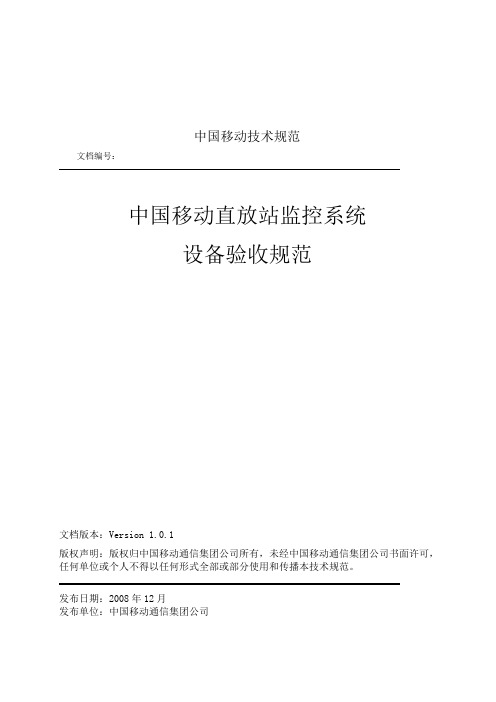
中国移动技术规范文档编号:中国移动直放站监控系统设备验收规范文档版本:Version 1.0.1版权声明:版权归中国移动通信集团公司所有,未经中国移动通信集团公司书面许可,任何单位或个人不得以任何形式全部或部分使用和传播本技术规范。
发布日期:2008年12月发布单位:中国移动通信集团公司文档说明:本技术规范为中国移动直放站监控系统设备验收规范。
本规范为直放站监控系统规范中的设备验收规范仅用于指导中国移动直放站监控系统建设,中国移动通信集团公司保留对本方案的解释权和修改权。
以下同志参加了本规范初稿的编写和讨论工作,表示感谢!徐海东、王烨、张潮、方鹏、丁三弟、钟学森、张辰、彭旭辉、李胜利、王红、方道奎、吴玲琦、魏崴、李雪峰、李承胜、师鑫、胡国云等编号说明:(本文档编号依照以下原则进行:x.y.z x: 大版本更新,文档结构变化y: 具体方案的更改,部分内容的修正z: 文字修改,奇数为包含对上一版修改记录的稿子偶数为对上修改稿的定稿)文档修改历史目录1范围 (10)2规范性引用文件 (10)3参考文献 (10)4缩略语 (10)5验收总原则 (10)5.1实现直放站设备的有效监控 (11)5.2对第三方测试单位的要求 (11)5.3对设备制造商的要求 (11)5.4验收测试分类 (12)5.5测试中的注意点 (12)6前期准备 (12)6.1组建监控系统(或起相同作用的测试系统) (12)6.2验收所需设备及工具 (12)6.3实验室验收测试环境和条件 (13)7验收测试项目 (14)7.1通信时延要求 (14)7.2通信方式要求 (14)7.3开站上报 (14)7.3.1测试前提 (14)7.3.2测试方法 (14)7.3.3测试内容 (15)7.3.4测试结果 (15)7.4基本信息查询 (15)7.4.1测试前提 (15)7.4.2测试方法 (15)7.4.3测试内容 (15)7.4.4测试结果 (16)7.5基本信息设置 (16)7.5.1测试前提 (16)7.5.2测试方法 (16)7.5.3测试内容 (17)7.5.3.1设置上报号码 (17)7.5.3.2设置站点编号 (17)7.5.3.3设置设备编号 (17)7.5.3.4设置“查询设置电话号码1~5” (17)7.5.3.5设置短信服务中心号码 (18)7.5.3.6监控中心IP地址和端口号 (18)7.5.4测试结果 (18)7.6下行链路 (19)7.6.1测试前提 (19)7.6.2测试方法 (20)7.6.3测试内容 (20)7.6.3.1下行输入功率电平 (20)7.6.3.2下行输出功率电平、远端下行输出功率电平 (21)7.6.3.3下行衰减、远端下行衰减值 (21)7.6.3.4下行实际增益 (22)7.6.3.5下行输入功率告警门限与下行输出功率告警门限 (22)7.6.3.6下行输入功率告警与下行输出功率告警 (22)7.6.4测试结果 (22)7.7上行链路 (23)7.7.1测试前提 (23)7.7.2测试方法 (23)7.7.3测试内容 (24)7.7.3.1上行输出功率电平(可选) (24)7.7.3.2上行衰减、远端上行衰减值 (24)7.7.3.3上行理论增益 (24)7.7.3.4上行输出过功率告警门限(可选) (25)7.7.3.5上行输出过功率告警(可选) (25)7.7.4测试结果 (25)7.8系统增益(用于微功率分布设备) (25)7.8.1测试前提 (25)7.8.2测试方法 (26)7.8.3测试内容 (26)7.8.4测试结果 (26)7.9光收功率/光发功率(可选) (26)7.9.1测试前提 (27)7.9.2测试方法 (27)7.9.3测试内容 (27)7.9.4测试结果 (27)7.10信道号 (27)7.10.1测试前提 (27)7.10.2测试方法 (28)7.10.3测试内容 (28)7.10.3.1选频设备信道号 (28)7.10.3.2移频选频直放站信道号 (28)7.10.4测试结果 (29)7.10.4.1工作信道号测试数据 (29)7.10.4.2移频信道号测试数据 (30)7.10.4.3测试结果 (30)7.11工作频带上/下边带信道号 (31)7.11.2测试方法 (31)7.11.3测试内容 (31)7.11.4测试结果 (31)7.12移频直放站工作频带/移频频带的上/下边带信道号 (31)7.12.1测试前提 (32)7.12.2测试方法 (32)7.12.3测试内容 (32)7.12.3.1工作频带上/下边带信道号 (33)7.12.3.2移频频带上/下边带信道号 (33)7.12.4测试结果 (33)7.12.4.1测试数据 (33)7.12.4.2测试结果 (34)7.13日常切换和节假日切换(用于载波调度器设备) (34)7.13.1测试方法 (37)7.13.2测试内容 (37)7.13.2.1设置、查询切换数据 (37)7.13.2.2射频信号切换 (37)7.13.3测试结果 (37)7.14功率渐衰过程控制时间和功率渐衰增益调节值(用于载波调度器设备) (37)7.14.1测试方法 (37)7.14.2测试内容 (38)7.14.2.1设置、查询切换数据 (38)7.14.2.2射频信号切换 (38)7.14.3测试结果 (38)7.15下行驻波比(对微型直放站以外的设备) (38)7.15.1测试前提 (38)7.15.2测试方法 (39)7.15.3测试内容 (39)7.15.3.1下行驻波比值 (39)7.15.3.2下行驻波比门限 (39)7.15.3.3下行驻波比告警 (39)7.15.4测试结果 (39)7.16下行驻波比告警(对微型直放站和微功率分布远端无线单元) (40)7.16.1测试方法 (40)7.16.2测试内容 (40)7.16.3测试结果 (40)7.17射频信号开关、远端射频信号开关状态 (40)7.17.1测试前提 (40)7.17.2测试方法 (40)7.17.3测试内容 (40)7.17.4测试结果 (41)7.18功放开关(用于基站放大器,其它设备类型可选) (41)7.18.1测试前提 (41)7.18.3测试内容 (41)7.18.4测试结果 (41)7.19上/下行信号旁路状态(用于塔放) (42)7.19.1测试前提 (42)7.19.2测试方法 (42)7.19.3测试内容 (42)7.19.3.1下行旁路状态检测 (42)7.19.3.2上行旁路状态检测 (42)7.19.4测试结果 (42)7.20信源信息 (43)7.20.1测试前提 (43)7.20.2测试方法 (43)7.20.3测试内容 (43)7.20.3.1信源信息六项 (44)7.20.3.2设置信源小区识别码参照值 (44)7.20.3.3信源变化告警 (44)7.20.4测试结果 (44)7.21功放过温 (44)7.21.1测试前提 (44)7.21.2测试方法 (44)7.21.3测试内容 (45)7.21.3.1功放温度值 (45)7.21.3.2功放过温告警门限 (45)7.21.3.3功放过温告警 (45)7.21.4测试结果 (45)7.22电源掉电告警 (45)7.22.1测试前提 (45)7.22.2测试方法 (46)7.22.3测试内容 (46)7.22.4测试结果 (46)7.23电源故障告警 (46)7.23.1测试前提 (46)7.23.2测试方法 (46)7.23.3测试内容 (46)7.23.4测试结果 (47)7.24监控模块电池故障告警 (47)7.24.1测试前提 (47)7.24.2测试方法 (47)7.24.3测试内容 (47)7.24.4测试结果 (47)7.25位置告警 (47)7.25.1测试方法 (47)7.25.2测试内容 (47)7.26门禁告警(可选) (48)7.26.1测试前提 (48)7.26.2测试方法 (48)7.26.3测试内容 (48)7.26.4测试结果 (48)7.27自激告警 (48)7.27.1测试前提 (48)7.27.2测试方法 (49)7.27.3测试内容(实验室) (49)7.27.4测试结果 (49)7.28本振失锁告警 (49)7.28.1测试前提 (49)7.28.2测试方法 (50)7.28.3测试内容 (50)7.28.4测试结果 (50)7.29光收发故障告警 (50)7.29.1测试前提 (50)7.29.2测试方法 (50)7.29.3测试内容 (50)7.29.4测试结果 (50)7.30主从监控链路告警 (50)7.30.1测试前提 (50)7.30.2测试方法 (51)7.30.3测试内容 (51)7.30.4测试结果 (51)7.31低电压告警(用于太阳能直放站) (51)7.31.1测试前提 (51)7.31.2测试方法 (51)7.31.3测试内容 (51)7.31.4测试结果 (52)7.32功放/低噪放故障告警 (52)7.32.1测试前提 (52)7.32.2测试方法 (52)7.32.3测试内容 (52)7.32.3.1上行功放/低噪放告警 (52)7.32.3.2下行功放/低噪放告警 (53)7.32.4测试结果 (53)7.33外部告警 (53)7.33.1测试前提 (53)7.33.2测试方法 (53)7.33.3测试内容 (53)7.33.4测试结果 (53)7.34其它模块告警 (54)7.34.2测试方法 (54)7.34.3测试内容 (54)7.34.4测试结果 (54)7.35塔顶放大器告警 (54)7.35.1测试前提 (54)7.35.2测试方法 (54)7.35.3测试内容 (54)7.35.4测试结果 (55)7.36功放旁路告警 (55)7.36.1测试前提 (55)7.36.2测试方法 (55)7.36.3测试内容 (55)7.36.4测试结果 (55)7.37射频电路故障告警、远端射频电路故障告警 (56)7.37.1测试方法 (56)7.37.2测试内容 (56)7.37.3测试结果 (56)7.38远端链路故障告警(用于微功率分布系统) (56)7.38.1测试前提................................................................................... 错误!未定义书签。
《铁路GSM-R数字移动通信系统编号计划(V3.0)》

TJ/DW084-2013铁路GSM-R数字移动通信系统编号计划Number Planning for the GSM-R Digital Mobile Communication System(V3.0)2013年1月前言本技术条件规定了中国铁路GSM-R数字移动通信系统的编号规则。
本技术条件系在铁道部《GSM-R数字移动通信网编号计划(V2.0)》(科技运〔2006〕119号)基础上修改完成的。
在执行过程中,各单位若发现另有需要修改和补充之处,请及时将意见及有关资料寄交主要起草单位北京全路通信信号研究设计院有限公司(北京市丰台区华源一里18号楼,100073),并抄送铁道部运输局(北京市海淀区复兴路10号,100844),供今后修订时参考。
本技术条件由铁道部运输局组织编制并负责解释。
主要起草单位:北京全路通信信号研究设计院有限公司。
参与起草单位:北京铁路通信技术中心。
主要起草人:周宇晖、屈毅、李莉、冯磊、石波、王芳、邓烨飞、刘清涛、尹毅、张卫军。
1 适用范围铁路GSM-R数字移动通信系统编号计划(以下简称GSM-R编号计划)主要包括用户编号、设备编号和拨号方式。
其中用户编号包括GSM-R网络用户号码、移动用户号码、固定用户号码、引示号、特服号码、IP地址、GPRS 域名以及与GSM-R业务相关的调度通信网用户号码等;设备编号包括GSM-R网络设备编号、信令点编码等;拨号方式包括GSM-R网内号码拨叫、MSC与调度通信网间号码拨叫、MSC与RBC间号码拨叫、铁路专用PSTN与GSM-R网间号码拨叫的传递格式和显示方式。
本编号计划适用于铁路GSM-R数字移动通信系统建设和运用管理。
2 规范性引用文件下列文件对于本标准的应用是必不可少的。
凡是注日期的引用文件,仅所注日期的版本适用于本文件。
凡是不注日期的引用文件,其最新版本(包括所有的修改单)适用于本文件。
(1) YDN 089-1998 No.7信令网技术体制(2) UIC Project EIRENE Functional Requirements SpecificationV7.3(3) UIC Project EIRENE System Requirements Specification V15.3(4) 3GPP TS 23.003 V10.3.0 (2011-09)Numbering, addressing andidentification(Release 10)(5) ITU-T E.164 The International Public TelecommunicationNumbering Plan3 缩略语以下缩略语适用于本文件。
CTC与其它系统的接口资料
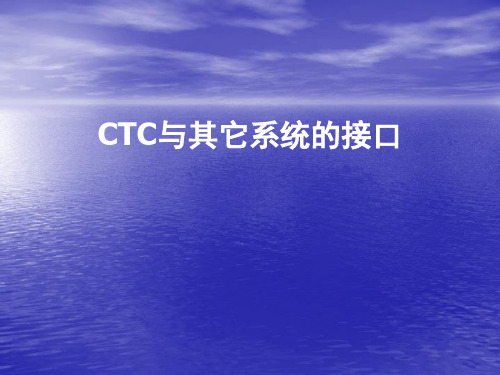
数据库 公用交
换表 CTC1专
用表 CTC2专
用表 ……
运行图信息(基本图、日班计划、 阶段计划、运行调整计划); 站存车、小编组、甩挂计划; 列车编组顺序表; 调度命令;调车计划;
通信服务
控制命令、 过程回执、 维护信息等
CTC应用服务器
运行图信息(基本图、日班计划、 阶段计划、运行调整计划); 站存车、小编组、甩挂计划; 列车编组顺序表; 调度命令;调车计划;
中心局域网 GSM-R 通信服务器
防火墙
路由器
GRIS
GRIS 路局GPRS节点
GSM-R与CTC/TDCS系统连接方式图
CTC与GSMR接口
GSM-R接口服务器(GRIS)有一对,CTC中心有一对 GSM-R通信服务器,均以双机热备的方式通过以太网建立 TCP/IP连接。
GSM-R接口服务器(GRIS)为服务器端,CTC中心的 GSM-R通信服务器为客户端。服务器端在TCP端口20002 上接收客户端的TCP连接请求。
GSM-R接口服务器与GSM-R通信服务器采用局域以太网连 接方式,如长距离条件下则采用光纤传输延伸局域网。
GSMR系统与CTC/TDCS系统都各自设置防火墙,以保证 网络数据传输的安全。CTC向GSMR发信息时要指定特定 的机车号和车次号;GSMR完成机车号和车次号的IP动态 寻址。
无线车次号
列车每通过一个列车信号机(进站信号机、出站 信号机、区间信号机)都会向CTC系统主动发 送无线车次信息;
车次信息中包括机车号、车次号、公里标、速度、 车长、车重、车数等数据;
CTC收到无线车次信息后,根据其中的公里标 检索列车位置,然后发送到特定的车站自律机, 车站自律机完成车次号校核功能。
GSM-R中继传输系统设备技术规范

科技司:运输局:各铁路局/公司,第一、二、三、四勘察设计院,铁科院,铁通公司,通号公司设计院,北京交通大学,电化局电测中心,电化局通号设计院,上海工程公司,京信、虹信、泰通公司。
部经规院(鉴定中心、标准所),部内计划、建设司。
科技司运输电务处熊杰46073《GSM-R数字移动通信网设备技术规范第五部分:中继传输系统(V1.0)》科技GSM-R 技术规范中继传输系统通知关于印发《GSM-R数字移动通信网设备技术规范第五部分:中继传输系统(V1.0)》的通知(此页无正文)为统一铁路GSM-R中继传输系统的技术标准,2006年11月2日,铁道部科技司、运输局在北京主持召开了《GSM-R数字移动通信网设备技术规范第五部分:中继传输系统(V1.0)》评审会。
铁道部经规院(鉴定中心、标准所),铁科院,第三、四设计院,太原局电务处,铁通公司等单位专家参加了会议。
评审委员会听取了编制组的汇报并逐条进行了认真讨论,就GSM-R中继传输系统的技术规范提出了合理和建设性意见并形成评审意见。
编制组已根据评审意见对技术规范进行了修改并报部,现将评审意见和《GSM-R数字移动通信网设备技术规范第五部分:中继传输系统(V1.0)》发给你们,请参照实行。
二OO七年四月三十日《GSM-R数字移动通信网设备技术规范第五部分:中继传输系统(V1.0)》评审意见2006年11月2日,铁道部科技司、运输局在北京通号设计院主持召开了“GSM-R数字移动通信网设备技术规范第五部分:中继传输系统设备(V1.0)”评审会。
评审委员会认真听取了编制单位的汇报,审查了有关文件,经认真讨论,形成评审意见如下:1、该技术规范内容全面,结构较合理,提供的技术文件齐全,符合审查要求。
2、该技术规范规定了中国铁路GSM-R中继传输系统的主要技术要求、设备类型及组成和设备主要技术要求等内容,可作为铁路GSM-R工程设计、产品制造、施工安装、设备维护、质量检验的技术依据。
中国移动广东公司GSM基站验收规范(V2.7)
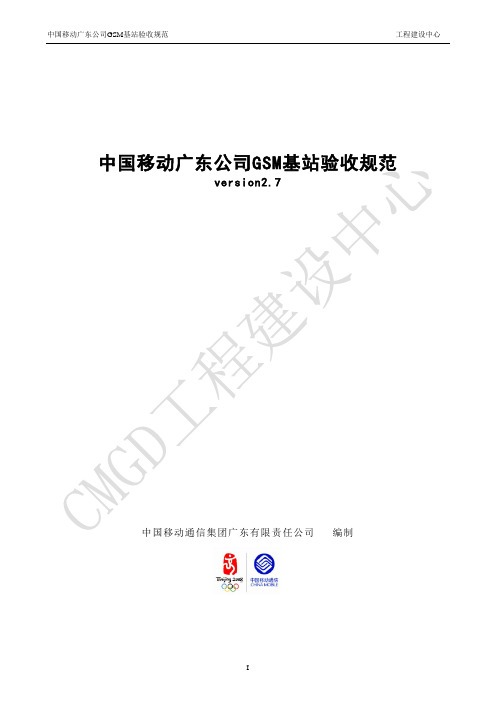
中国移动广东公司GSM基站验收规范version2.7中国移动通信集团广东有限责任公司编制目录目录 (I)第1章总则 (1)第2章基站机房 (2)2.1机房高度面积 (2)2.2机房荷载 (2)2.3机房改造要求 (2)2.4机房照明 (2)2.5机房环境 (3)2.6机房防火 (3)2.7机房防水 (3)2.8机房密封 (3)2.9机房温湿度 (3)2.10机房空调 (3)第3章无线设备 (4)3.1室内无线设备安装 (4)3.1.1走线通道 (4)3.1.2无线机架的安装 (4)3.1.3机架间的电缆 (5)3.1.4机柜内部电缆 (6)3.1.5机架内设备单元的安装 (6)3.1.6标签 (6)3.1.7配线架(DF 架) 的安装 (6)3.1.8PCM线安装 (7)3.2室内接地 (7)3.2.1联合接地 (7)3.2.2室内接地汇集线 (7)3.2.3入机房的接地引入线 (8)3.2.4设备的母地线 (8)3.2.5馈线的母地线 (8)3.2.6设备接地 (8)3.2.7室内馈线接地 (9)3.3室外天馈系统 (9)3.3.1天线设备 (9)3.3.2室外馈线 (11)3.3.3室外天馈系统接地 (11)3.4无线设备调测 (13)3.4.1无线指标检查 (13)3.4.2爱立信RBS2000型基站 (13)3.4.3爱立信RBS200型基站.......................................... 错误!未定义书签。
3.4.4华为BTS3012型基站 (14)3.4.5爱立信RBS6000型基站 (14)第4章电源设备 (16)4.1电源设备安装 (16)4.1.1交流设备安装 (16)4.1.2进机房电源线 (16)4.1.3开关电源设备安装 (17)4.1.4直流变换(DC-DC)设备安装 (17)4.1.5直流电缆 (17)4.1.6熔丝开关 (20)4.1.7电池安装 (20)4.1.8标签 (21)4.1.9设备外观 (21)4.2电源设备调测 (21)4.2.1交流电输入 (21)4.2.2直流输出 (21)4.2.3系统均流 (21)4.2.4监控单元 (21)4.2.5电池供电 (22)4.2.6参数设置 (22)第5章外部告警 (23)5.1外部告警设备性能及安装 (23)5.1.1温度告警 (23)5.1.2烟感告警 (23)5.1.3湿度告警 (23)5.1.4水浸告警 (24)5.1.5门控告警 (24)5.2外部告警的连接 (24)5.3外部告警的设置 (24)5.4外部告警的测试 (25)5.4.1温度告警测试 (25)5.4.2烟雾告警测试 (26)5.4.3电源告警测试 (26)第6章室外型基站无线设备安装 (28)6.1RRU光纤、直流电源线室外部分安装要求 (28)6.2华为DBS3900 设备 (28)6.2.1无线设备安装 (28)6.2.2线缆布放 (33)6.2.3室外天馈系统 (35)6.3爱立信RBS2111/RBS6601设备 (36)6.3.1室外防盗铁笼安装 (36)6.3.2无线设备安装 (36)3.1.9基站调测.................................................... 错误!未定义书签。
CTCS3级列控系统与GSMR网络接口规范资料

CTCS-3级列控系统与GSM-R网络接口规范(V1.0)2008年12月修改记录目录1.引言 (1)1.1. 目的和范围 (1)1.2. 术语和定义 (1)1.3. 缩略语 (1)1.4. 参考文献 (3)2.CTCS-3级列控系统与GSM-R网络之间的界面 (6)3.I FIX接口 (7)3.1. 接口定义 (7)3.1.1.一般规定 (7)3.1.2.接口协议栈 (7)3.2. 物理、电气及机械特性 (8)3.3. I FIX接口上的数据传输 (8)3.4. I FIX接口上的信令传输 (8)3.4.1.应符合的规范 (8)3.4.2.信令流程 (8)4.I GSM-R接口 (18)4.1. 接口定义 (18)4.1.1.一般规定 (18)4.1.2.接口操作模式 (18)4.2. 物理、电气及机械特性 (19)4.3. I GSM-R接口上的数据传输 (21)4.4. I GSM-R接口上的信令传输 (22)4.5. AT命令 (24)4.5.1.AT命令定义 (24)4.5.2.AT命令语法 (24)4.5.3.TE-TA接口命令 (24)4.5.4.呼叫控制命令 (26)4.5.5.通用DCE控制命令 (32)4.5.6.网络业务相关命令 (33)4.5.7.基本呼叫流程 (33)5.编号方案 (36)1.引言1.1.目的和范围1.1.1.1.为明确CTCS-3级列控系统与GSM-R网络之间的接口要求,为CTCS-3级列控产品的研发、测试、互联互通及承载CTCS-3级列控业务的GSM-R网络设计、测试提供技术依据,特制订本规范。
1.1.1.2.本规范规定了CTCS-3级列控系统与GSM-R网络之间各接口的定义、物理、电气、机械特性及各接口的数据传输、信令流程等内容。
1.2.术语和定义1.2.1.1.移动终端MT0:MT0是完整的移动台,它包括数据终端和适配功能,但不提供外部终端接口。
适合我国铁路应用的GSM-R技术规范体系

( )欧 洲各 国 G M —R核心 网大 多采用一家设备,智能 2 S 网采用厂家 内部私有协议 。而我国 G M —R核心 网为多厂家 S 组 网环境 ,对于智能业务,需要统 一规 范业务的实现流程 。 ( )欧洲应用范 围小,移动通信 业务简单,主要承载列 3
该 规 范 的 制 定 有 利 于 GS —R 技 术 规 范 的 制 定 、 理 解 M 与执 行 。
地 利用频谱、码号等资源 :另一方面,也 为各 厂家平等接人
提 供 可 循 的技 术 依 据 , 为 网 络 设 备 质 量 认 证 和 监 督 的 提 供
图l G M — 技 术规 范 层 次 关 系示 意 图 S R
动 通信 网名 词术语 ,规范 内容应包括 GS —R通信 的相关 M
术 语及 其解释 。
与规范 ,一 方面 为 网络规 划 、建设 和运 维管 理提 供技 术依
据 ,确 保 网 络 完 整 、统 一 和 安全 可 靠 , 提 高 服 务 质 量 、合 理
GS —R 网除 了上 述 两 项 主 要 业 务 外 , 还 需 M
引入 G R P S系统 ,承载调 度命 令 、车次号 、
调 车 监 控 信 号 等 信 息 传 送 , 此 外 , 由 于 运 输 指 挥 作 业 方 式 不 同 , 列 车 调 度 通 信 具 体 要 求也 有所 不 同 。 因此 , 需 要 针 对 每 种 具 体 应 用 ,制定 相应 的规 范 。
( )欧洲 国家网络 规模 小, 而我 国 GS — 1 M R网络规 模
大 ,应 采 取 全 网 统 一 规 划 、分 布 实 施 建 网 策 略 , 因此 ,在 建
CTC与GSM-R接口标准

-3 -
器完成传输层和应用层通信协议的转换以及 IP 地址的转换。 3.3.2 数据的存储转发。GPRS 接口服务器采用存储转发的机制,完成 行车作业数据的传送。 3.3.3 IP 地址更新。每个 GPRS 接口服务器均存储所有路局 GPRS 接口 服务器的 IP 地址。当机车运行至新 CTC/TDCS 区段时,若 CTC/TDCS 中心未能及时通过 GPRS 接口服务器通知 CIR 进行 IP 地址更新,GPRS 接口服务器负责通知 CIR 进行 GPRS 当前接口服务器 IP 地址的更新操 作。 3.3.4 信息安全功能。防止非法的移动用户利用 GPRS 接口服务器进行 数据传输,同时也防止未经授权的固定用户向机车综合无线通信设备传 送数据。 3.3.5 告警提示功能。当 GRIS 与 GSM-R 通信服务器通信或 GGSN 之间 发生通信异常时,可自动发出声光告警和信息提示。 3.3.6 日志记录和管理功能。应对所有运行数据和操作进行记录,并能 根据需要查询和统计,生成报表。
3.2 连接方式 铁路 GPRS 与 CTC/TDCS 系统连接方式如图 1 所示。
-2 -
图 1 铁路 GPRS 与 CTC/TDCS 系统连接方式图
3.2.1 GPRS 接口服务器负责 GPRS 网络与 CTC/TDCS 系统的通信,通 过局域以太网与 GGSN 连接。 3.2.2 CTC/TDCS 系统通过 GSM-R 通信服务器与 GPRS 接口服务器连 接。 3.2.3 GSM-R 通信服务器与 GPRS 接口服务器采用局域以太网连接方 式,长距离条件下采用光纤传输延伸局域网。 3.2.4 GPRS 网络与 CTC/TDCS 系统都各自设置防火墙,以保证自身网 络安全。
《铁路GSM-R数字移动通信系统编号计划(V3.0)》

接入点名称 鉴权中心 基站色码 基站识别码 国家代码 车辆功能号码 全球小区识别码 车辆号码 小区识别码 呼叫类型 调度集中控制系统 中国列车控制系统 调度用户区域标识 列控设备动态监测系统 域名服务器 机车号 机车功能号 欧洲列车控制系统 功能码 功能号 组呼号码 GPRS 网关支持节点 通用分组无线业务 全球移动通信系统 铁路数字移动通信系统 组呼寄存器 全局码 归属位置寄存器 切换号码 国际代码 国际移动设备识别码 国际移动用户识别码 互联网规程 智能外设 位置区码 位置区识别码 位置寻址 移动国家代码
TJ/DW084-2013
铁路 GSM-R 数字移动通信系统编号计划
Number Planning for the GSM-R Digital Mobile Communication System (V3.0)
2013 年 1 月
前 言
本技术条件规定了中国铁路GSM-R数字移动通信系统的编号规则。 本技术条件系在铁道部《GSM-R数字移动通信网编号计划(V2.0)》(科 技运〔2006〕119号)基础上修改完成的。在执行过程中,各单位若发现另 有需要修改和补充之处,请及时将意见及有关资料寄交主要起草单位北京 全 路 通 信 信 号 研 究 设 计 院 有 限 公 司 ( 北 京 市 丰 台 区 华 源 一 里 18 号 楼 , 100073),并抄送铁道部运输局(北京市海淀区复兴路10号,100844),供 今后修订时参考。 本技术条件由铁道部运输局组织编制并负责解释。 主要起草单位:北京全路通信信号研究设计院有限公司。 参与起草单位:北京铁路通信技术中心。 主要起草人:周宇晖、屈毅、李莉、冯磊、石波、王芳、邓烨飞、
刘清涛、尹毅、张卫军。
I
1 适用范围 铁路GSM-R数字移动通信系统编号计划(以下简称GSM-R编号计划)主 要包括用户编号、设备编号和拨号方式。其中用户编号包括GSM-R网络用户 号码、移动用户号码、固定用户号码、引示号、特服号码、IP地址、GPRS 域 名以及与GSM-R业务相关的调度通信网用户号码等;设备编号包括GSM-R网 络设备编号、信令点编码等;拨号方式包括GSM-R网内号码拨叫、MSC与调 度通信网间号码拨叫、MSC与RBC间号码拨叫、铁路专用PSTN与GSM-R网间号 码拨叫的传递格式和显示方式。 本编号计划适用于铁路GSM-R数字移动通信系统建设和运用管理。
GSM-R系统要求

简介在《用于铁路的全球移动通讯系统(GSM-R)》中简要介绍了开发GSM-R的项目和国际铁路联盟欧洲部如何做出选择GSM-R的决定。
本文将继续讨论标准GSM是如何被通过改进和增加新功能来适应铁路通讯的要求与限制的。
本文的目的不是详细讨论GSM-R的系统要求规范(SRS), 而是帮助读者了解其相关内容和范围。
本文选择了有关频谱和覆盖的具体事项,以及为适应铁路应用而在标准GSM上增加新功能加以讨论。
下图(图1)取自EIRENE(欧洲铁路无线通讯增强集成网)的系统要求规范,它展示了GSM-R包括的范围。
图2展示了最早的用户要求规范是如何逐渐发展成具体的技术规范的,本图还试图说明标准GSM是在何种程度上满足解决方案的。
标准或衍生的GSM中没有铁路所特别需要的功能是不可避免的,这导致了一些专门为铁路而设的功能的产生,本文以后的章节将描述这些功能。
图 1 EIRENE规范及接口GSM-R功能要求规范和系统要求规范功能要求规范(FRS)是一种高层文件,它从用户的角度,向设计者和使用者明确地提供系统要求。
GSM-R的功能要求规范是由工程师和用户共同开发的,当它完成并由用户签字认可后,下一步开发技术解决方案的工作便可以开始了。
下一层更深的技术规范被称为系统要求规范(SRS).图2显示了系统要求规范在开发过程中的技术深度和时间跨度。
欧洲铁路无线通讯增强集成网(EIRENE)和欧洲移动无线通讯网(MORANE)在1994年至2000年联合开发了GSM-R。
图 2EIRENE项目负责要求的制订,MORANE项目负责技术开发和样机研制,要求尽可能使用GSM标准。
作为EIRENE在1992至93年的可行性研究的一部分,一份“用户要求与限制”被提了出来。
可行性研究的目的是考察是否有一种可供铁路使用的新型移动通讯系统标准。
铁路在1993年选择了GSM作为新系统的基础,这一选择意味着新系统超了一些近路,因为部分问题已经有了解决。
运基通信电[2006]185号-铁道部CTC与GSM-R接口标准(4-29)
![运基通信电[2006]185号-铁道部CTC与GSM-R接口标准(4-29)](https://img.taocdn.com/s3/m/9dcd5816964bcf84b9d57b8a.png)
GSM-R与CTC/TDCS系统数据传输接口技术条件(暂行)目录1适用范围 (1)2引用和参考标准 (1)3GSM-R与CTC/TDCS系统的连接 (2)3.1设备配置 (2)3.2连接方式 (2)3.3GRIS功能 (3)4通信方式 (4)5信息内容 (5)5.1IP地址信息 (5)5.1.1IP地址查询信息 (5)5.2行车业务信息 (6)5.3CIR与GRIS通信协议 (6)5.3.1通用格式 (6)5.3.2应答方式 (6)5.3.3端口代码分配 (6)5.3.4业务类型分配 (6)5.3.5UDP端口分配 (7)5.3.6GRIS IP地址的获取 (7)5.3.7车次号校核信息 (10)5.3.8调度命令信息 (11)5.3.9列车启动和停稳信息 (12)5.4GRIS与GSM-R通信服务器通信协议 (13)5.4.1通用格式 (13)5.4.2应答方式 (14)5.4.3TCP端口分配和通信模式 (14)5.4.4数据传输 (14)5.4.5越界指示及其响应 (15)5.4.6活动性检测数据信息 (16)6接口设备技术要求 (17)7名词术语及缩略语 (17)GSM-R与CTC/TDCS系统数据传输接口规范(暂行)1适用范围为实现铁路GSM-R数字移动通信系统与CTC/TDCS系统的数据传输,本规范规定了我国铁路GSM-R数字移动通信系统与CTC/TDCS系统接口的设备配置、连接方式、通信方式、交换信息内容、通信协议和接口设备技术要求。
本规范是铁路GSM-R与信息系统数据传输接口规范的组成部分。
本规范适用于工程设计、生产制造、施工安装及维护管理。
2引用和参考标准下列标准所包含的条文,通过在本规范中引用而成为本规范的条文。
在标准出版时,所示版本均为有效。
所有标准都会被修订,使用本规范的各方应探讨使用下列标准最新版本的可能性。
分散自律调度集中系统技术条件(暂行)DMIS、调度集中、调度监督系统间的数据通信规程分散自律调度集中系统软件通讯协议标准(暂行)机车综合无线通信设备技术条件(V1.0)铁路运输调度指挥管理信息系统(DMIS)技术标准(暂行)铁路GSM-R数字移动通信网络编号计划(V1.0)调度命令无线传送系统技术规范(V4.0)GSM-R车次号传送系统主要技术条件(暂行)GSM-R调度命令传送系统主要技术条件(暂行)3GSM-R与CTC/TDCS系统的连接本章规定了机车综合无线通信设备与CTC/TDCS系统之间采用GPRS方式进行数据传输时的设备配置和连接方式。
GSM-R中继传输系统设备技术规范
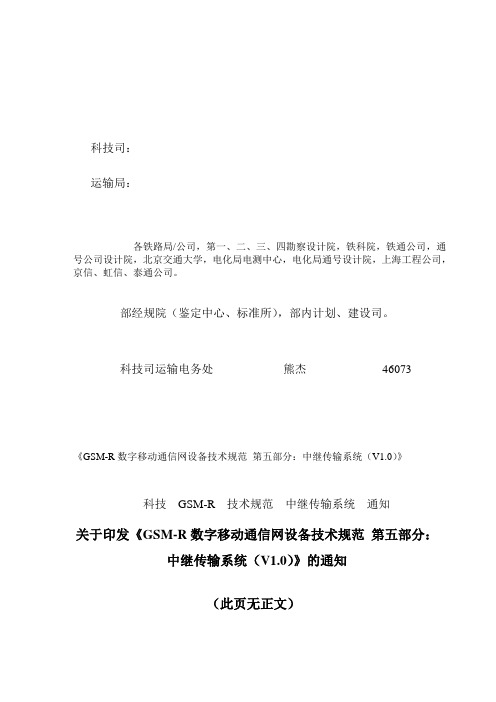
科技司:运输局:各铁路局/公司,第一、二、三、四勘察设计院,铁科院,铁通公司,通号公司设计院,北京交通大学,电化局电测中心,电化局通号设计院,上海工程公司,京信、虹信、泰通公司。
部经规院(鉴定中心、标准所),部内计划、建设司。
科技司运输电务处熊杰46073《GSM-R数字移动通信网设备技术规范第五部分:中继传输系统(V1.0)》科技GSM-R 技术规范中继传输系统通知关于印发《GSM-R数字移动通信网设备技术规范第五部分:中继传输系统(V1.0)》的通知(此页无正文)为统一铁路GSM-R中继传输系统的技术标准,2006年11月2日,铁道部科技司、运输局在北京主持召开了《GSM-R数字移动通信网设备技术规范第五部分:中继传输系统(V1.0)》评审会。
铁道部经规院(鉴定中心、标准所),铁科院,第三、四设计院,太原局电务处,铁通公司等单位专家参加了会议。
评审委员会听取了编制组的汇报并逐条进行了认真讨论,就GSM-R中继传输系统的技术规范提出了合理和建设性意见并形成评审意见。
编制组已根据评审意见对技术规范进行了修改并报部,现将评审意见和《GSM-R数字移动通信网设备技术规范第五部分:中继传输系统(V1.0)》发给你们,请参照实行。
二OO七年四月三十日《GSM-R数字移动通信网设备技术规范第五部分:中继传输系统(V1.0)》评审意见2006年11月2日,铁道部科技司、运输局在北京通号设计院主持召开了“GSM-R数字移动通信网设备技术规范第五部分:中继传输系统设备(V1.0)”评审会。
评审委员会认真听取了编制单位的汇报,审查了有关文件,经认真讨论,形成评审意见如下:1、该技术规范内容全面,结构较合理,提供的技术文件齐全,符合审查要求。
2、该技术规范规定了中国铁路GSM-R中继传输系统的主要技术要求、设备类型及组成和设备主要技术要求等内容,可作为铁路GSM-R工程设计、产品制造、施工安装、设备维护、质量检验的技术依据。
IMTDSFDD(WCDMA)系统Gn和Gp接口GPRS隧道协议技术规范
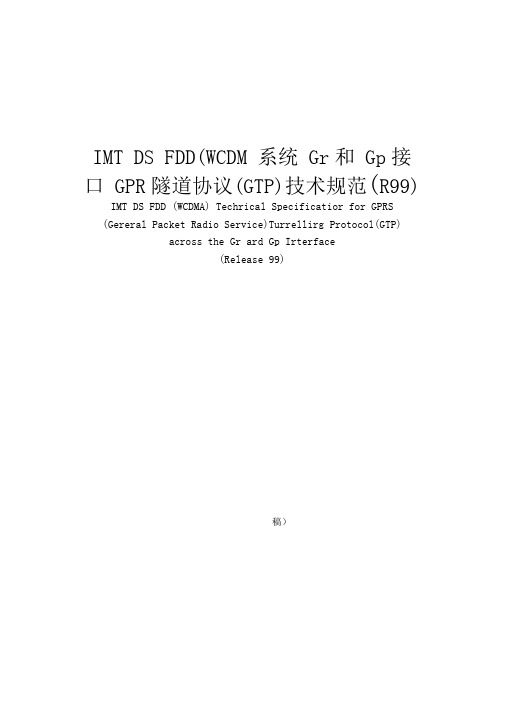
IMT DS FDD(WCDM 系统 Gr和 Gp接口 GPR隧道协议(GTP)技术规范(R99) IMT DS FDD (WCDMA) Techrical Specificatior for GPRS(Gereral Packet Radio Service)Turrellirg Protocol(GTP)across the Gr ard Gp Irterface(Release 99)稿)本规范是在3GPP技术规范TS 29.060 “3GPP TSG CN GPRS通用分组无线业务)隧道协议(GTP Gn和Gp接口(R99”(2001年12月版本3.b.0 )基础上制定的,主要内容与上述标准等效。
Gn和Gp接口是指IMT DS FDD(WCDM系统核心网络分组域中 GSN节点(GPRSfe持节点)之间的接口,这是一个开放的系统互联接口。
GPR擬道协议GTP是用于GSN节点之间的接口协议。
GTP协议由GTP g制面和用户面协议组成。
GTP 协议控制平面完成移动台MS接入分组网络的隧道控制和管理功能,消息主要执行建立、修改和删除GSN之间隧道功能,同时还负责GSN节点间的移动性管理、位置管理、路径管理功能。
GTP协议用户平面负责数据在隧道中传输,以及传输隧道的部分维护功能。
GTP协议用户平面同时使用在 WCDM系统无线子系统和核心网络分组域之间的Iu接口,用于Iu-PS接口用户平面的上层消息的承载。
本规范的 GTP协议用户面同样适用于 Iu-PS。
支持计费功能的GTP协议称为GTP协议GTP是用于产生计费话单的网络单元(SGSN GGSN和计费网关功能单元(CGF之间的接口协议。
GTP协议基于 GTP v0,在3GPP技术规范TS 12.15中有详细规定,不在本规范的描述范围之中。
GTP协议的要求为可选。
本规范的制定可满足我国WCDM系统设备开发和引进的需要,保证运营者采用不同厂家(公司)的设备联网时实现互通。
09-第九分册:数据传输应用接口技术条件2-2
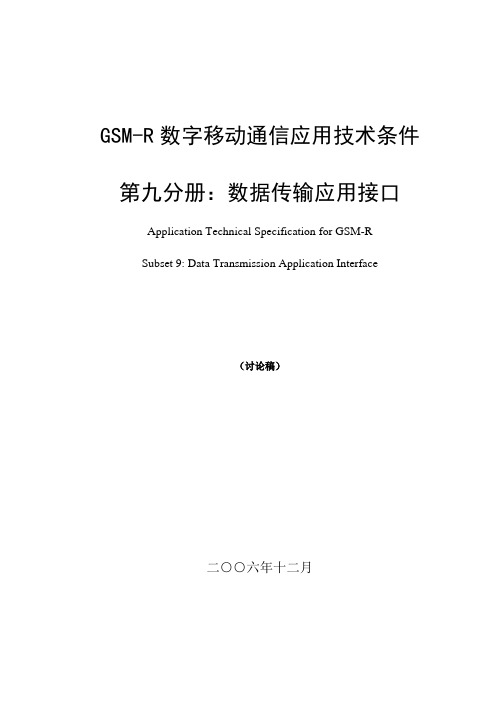
GSM-R数字移动通信应用技术条件第九分册:数据传输应用接口Application Technical Specification for GSM-RSubset 9: Data Transmission Application Interface(讨论稿)二○○六年十二月目次目次 (I)前言 (I)1 范围 (2)2 规范性引用文件 (2)3 术语和定义(名词术语及缩略语) (2)4 GSM-R分组域应用接口 (3)5 GSM-R电路域应用接口 (10)6 接口设备技术要求 (13)附录A 本规范用词说明 (14)附录B《GSM-R数字移动通信应用技术条件第九分册:数据传输应用接口》修改说明 (14)前言根据铁道部科技司《关于加快开展中国铁路GSM-R系统技术规范编制工作的通知》(科技运[2006]85号文),本技术条件对铁道部运输局2006年6月发布的《GSM-R与CTC/TDCS系统数据传输接口技术条件(暂行)》(运基通信[2006]185号)进行修改,是中国铁路GSM-R数字移动通信网(以下简称“GSM-R 网”)的系列技术规范文件之一,随着网络、业务和技术的发展,还可能继续完善升级。
在执行过程中,各单位若发现另有需要修改和补充之处,请及时将意见及有关资料寄交起草单位铁道科学研究院(北京市海淀区西直门外大柳树路2号,铁道科学研究院通信信号研究所,100081),并抄送铁道部科技司(北京市复兴路10号,100844),供今后修订时参考。
本技术条件由铁道部组织编制并负责解释。
本技术条件主编单位:铁道科学研究院。
本技术条件参编单位:卡斯柯信号有限公司、北京交通大学、北京全路通信信号研究设计院。
本技术条件主要起草人:沈京川、蔺伟、曹桂均、金亮、杨焱、石波。
GSM-R数字移动通信应用技术条件第九分册:数据传输应用接口1 范围本技术条件规定了GSM-R数字移动通信系统与铁路各信息系统之间数据传输应用接口,包括设备配置、连接方式、通信方式、业务信息、通信协议和设备技术要求等方面的内容。
